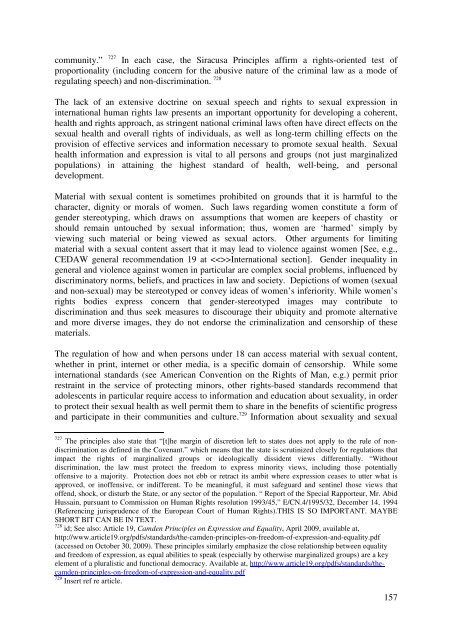SEXUAL HEALTH AND HUMAN RIGHTS A legal and ... - The ICHRP
SEXUAL HEALTH AND HUMAN RIGHTS A legal and ... - The ICHRP
SEXUAL HEALTH AND HUMAN RIGHTS A legal and ... - The ICHRP
Create successful ePaper yourself
Turn your PDF publications into a flip-book with our unique Google optimized e-Paper software.
community.” 727 In each case, the Siracusa Principles affirm a rights-oriented test of<br />
proportionality (including concern for the abusive nature of the criminal law as a mode of<br />
regulating speech) <strong>and</strong> non-discrimination. 728<br />
<strong>The</strong> lack of an extensive doctrine on sexual speech <strong>and</strong> rights to sexual expression in<br />
international human rights law presents an important opportunity for developing a coherent,<br />
health <strong>and</strong> rights approach, as stringent national criminal laws often have direct effects on the<br />
sexual health <strong>and</strong> overall rights of individuals, as well as long-term chilling effects on the<br />
provision of effective services <strong>and</strong> information necessary to promote sexual health. Sexual<br />
health information <strong>and</strong> expression is vital to all persons <strong>and</strong> groups (not just marginalized<br />
populations) in attaining the highest st<strong>and</strong>ard of health, well-being, <strong>and</strong> personal<br />
development.<br />
Material with sexual content is sometimes prohibited on grounds that it is harmful to the<br />
character, dignity or morals of women. Such laws regarding women constitute a form of<br />
gender stereotyping, which draws on assumptions that women are keepers of chastity or<br />
should remain untouched by sexual information; thus, women are ‘harmed’ simply by<br />
viewing such material or being viewed as sexual actors. Other arguments for limiting<br />
material with a sexual content assert that it may lead to violence against women [See, e.g.,<br />
CEDAW general recommendation 19 at International section]. Gender inequality in<br />
general <strong>and</strong> violence against women in particular are complex social problems, influenced by<br />
discriminatory norms, beliefs, <strong>and</strong> practices in law <strong>and</strong> society. Depictions of women (sexual<br />
<strong>and</strong> non-sexual) may be stereotyped or convey ideas of women’s inferiority. While women’s<br />
rights bodies express concern that gender-stereotyped images may contribute to<br />
discrimination <strong>and</strong> thus seek measures to discourage their ubiquity <strong>and</strong> promote alternative<br />
<strong>and</strong> more diverse images, they do not endorse the criminalization <strong>and</strong> censorship of these<br />
materials.<br />
<strong>The</strong> regulation of how <strong>and</strong> when persons under 18 can access material with sexual content,<br />
whether in print, internet or other media, is a specific domain of censorship. While some<br />
international st<strong>and</strong>ards (see American Convention on the Rights of Man, e.g.) permit prior<br />
restraint in the service of protecting minors, other rights-based st<strong>and</strong>ards recommend that<br />
adolescents in particular require access to information <strong>and</strong> education about sexuality, in order<br />
to protect their sexual health as well permit them to share in the benefits of scientific progress<br />
<strong>and</strong> participate in their communities <strong>and</strong> culture. 729 Information about sexuality <strong>and</strong> sexual<br />
727 <strong>The</strong> principles also state that “[t]he margin of discretion left to states does not apply to the rule of nondiscrimination<br />
as defined in the Covenant.” which means that the state is scrutinized closely for regulations that<br />
impact the rights of marginalized groups or ideologically dissident views differentially. “Without<br />
discrimination, the law must protect the freedom to express minority views, including those potentially<br />
offensive to a majority. Protection does not ebb or retract its ambit where expression ceases to utter what is<br />
approved, or inoffensive, or indifferent. To be meaningful, it must safeguard <strong>and</strong> sentinel those views that<br />
offend, shock, or disturb the State, or any sector of the population. “ Report of the Special Rapporteur, Mr. Abid<br />
Hussain, pursuant to Commission on Human Rights resolution 1993/45,” E/CN.4/1995/32, December 14, 1994<br />
(Referencing jurisprudence of the European Court of Human Rights).THIS IS SO IMPORTANT. MAYBE<br />
SHORT BIT CAN BE IN TEXT.<br />
728 id; See also: Article 19, Camden Principles on Expression <strong>and</strong> Equality, April 2009, available at,<br />
http://www.article19.org/pdfs/st<strong>and</strong>ards/the-camden-principles-on-freedom-of-expression-<strong>and</strong>-equality.pdf<br />
(accessed on October 30, 2009). <strong>The</strong>se principles similarly emphasize the close relationship between equality<br />
<strong>and</strong> freedom of expression, as equal abilities to speak (especially by otherwise marginalized groups) are a key<br />
element of a pluralistic <strong>and</strong> functional democracy. Available at, http://www.article19.org/pdfs/st<strong>and</strong>ards/thecamden-principles-on-freedom-of-expression-<strong>and</strong>-equality.pdf<br />
729 Insert ref re article.<br />
157

















